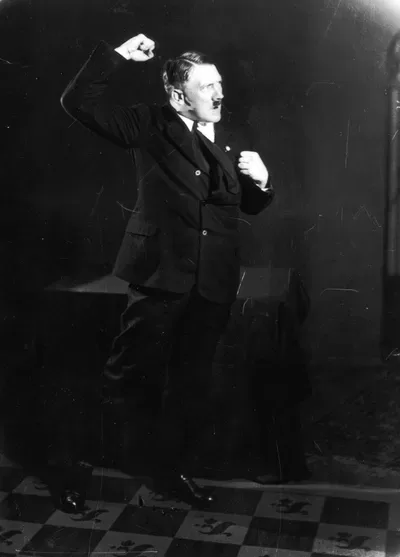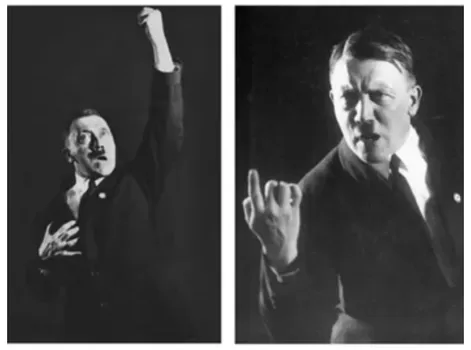German photographer Heinrich Hoffman made a series of nine photographs of his friend, fledgling politician Adolf Hitler as he practiced his public speaking histrionics.
The two men spent hours photographing Hitler as he practiced his persuasive speaking in front of a mirror whilst listening to recordings of Hitler’s speeches. They then examined the photographs to see the effectiveness of each dramatic pose.




Hitler realised the importance of these photographs, particularly as Hitler was presenting himself as a natural leader and public speaker.
After seeing the photographs, Hitler ordered Hoffmann to destroy the negatives, but he disobeyed and the photos resurfaced after WWII ended and were published in Hoffman’s 1955 book, Hitler Was My Friend: The Memoirs of Hitler’s Photographer.
Hitler and propaganda
Hitler served nine months of a five year sentence in Landsberg Prison for treason following a failed coup against the Weimar Government known as the Beer Hall Putsch in November of 1923. After his release from prison, where he wrote Mein Kampf, Hitler began his political campaign to gain power legally instead of by revolution or force.
Two chapters of Mein Kampf were devoted to the study and practice of propaganda: VI “War Propaganda”, and XI “Propaganda and Organization”. Hitler recognised the importance of mass media, and he began developing his public image, Nazi propaganda, his apotheosis and cult of personality.
“All propaganda must be presented in a popular form and must fix its intellectual level so as not to be above the heads of the least intellectual of those to whom it is directed.”
“The art of propaganda consists precisely in being able to awaken the imagination of the public through an appeal to their feelings, in finding the appropriate psychological form that will arrest the attention and appeal to the hearts of the national masses.”
“All effective propaganda must be confined to a few bare essentials and those must be expressed as far as possible in stereotyped formulas.”
Adolf Hitler in Mein Kampf




Hitler was released from prison on 20 December 1924. As a condition of his parole, Hitler was forbidden to speak in public until 1927 – he referred to this time as “The Quiet Years”.
Some reports suggest that Heinrich Hoffman made these photos of Adolf Hitler in 1925 in the months after his release. Others claim that the photos were made in 1927 as he prepared his return to public speaking.




It is doubtful that Brecht knew of Hoffman’s secret photos of Hitler as they did not surface until after WWII ended in 1945. Resistible Rise of Arturio Ui was written in 1941. The images were published in Hoffman’s 1955 book, Hitler Was My Friend: The Memoirs of Hitler’s Photographer.
Brecht however was an astute political analyst so it is plausible and commendable that Brecht observed Hitler’s rehearsed dramatic histrionics and referenced them by suggesting that Hitler had lessons from an actor.
Roger Moorhouse, a historian wrote in the introduction to Hoffman’s book, Hitler Was My Friend: The Memoirs of Hitler’s Photographer:
‘It makes perfect sense that he would be doing this.
‘We have this image now of Hitler almost as a buffoon, but he had a lot of charisma and his speeches made people sincerely believe he would lead them back to greatness.
‘He was an absolutely spellbinding public speaker and these pictures show that it was something he worked very hard on.
‘When you listen to his speeches now, he sounds like a ranting, raving maniac, but we know that it came across in a very persuasive way.
‘These pictures give an important insight into how he practised. He was a showman and rehearsed his gestures to get a particular reaction from his audiences.
‘He experimented with his own image and asked Hoffmann to take photographs for him to review. Then he’d look at them and say “no, that looks silly” or “I’m never doing that again”.
‘He used Hoffmann as a sounding board, but never intended the images to be published.
‘He was a very modern politician in that way. He was concerned about how he looked and his public persona.’
Roger Moorhouse
In writing this, I did search to see if Hitler did have acting lessons but couldn’t find any references, although his love of films is well documented and he cultivated friendships with actors. If you find a reference to Hitler taking acting lessons, please comment below.






A question of genre
This series of photographs is almost unique in that it is difficult to identify their genre. They are technically not portraits, their purpose was more sinister.
Documentary photography aims to capture reality and tell a true story. They are not documentary, they are not recording an event for prosperity as they were supposed to be destroyed after examination by Hitler.
Hoffman’s photos are neither Photojournalism (reportage) or Editorial – they were not meant to be seen by anyone else.
Hitler was a keen proponent of Propaganda, he appointed Goebbels as his Minister for Propaganda. While these photos were not propaganda for publication purposes, Hitler used these images to study his facial expressions, hand gestures and poses, examining their effectiveness in convincing his audience that he was a natural, powerful leader and orator.
In some ways they are like pornography of oneself, their purpose is self-gratification. Self-critique, a photographer-assisted ‘selfie’ for his self-gratification. Hitler’s use of the mirror in Hoffman’s images shows he was an active participant in the formation of the poses. He knew exactly what he was doing and wanted to achieve in these photos.
In some ways these photos are similar to a body builder or dancer posing in front of a mirror so they can see which poses show off their work and ideal of themselves to their intended audience.
Obviously, the photos are controversial in their content. Their context should be seen, examined and shared so that people are aware of the constructed image of not only Hitler, but the modern politician.
Henrich Hoffman
Hoffman joined the Nazi Party (NSDAP) on 6 April 1920, soon after it was formed on 24 February 1920. He was member No. 57. After Hitler took over the party in 1921, he appointed his close personal friend and confidant Hoffmann as his official photographer.
In 1929, Hoffmann introduced Hitler to Eva Braun, a 17-year-old salesgirl, studio assistant and model working in Hoffman’s photo studio, and the pair started their relationship about two years later.
During their 25-year long symbiotic relationship, Hoffman took more than ten thousand photographs of Hitler and managed the world’s most extensive photographic archives with over two million photos, a huge number in the days of film photography.
The photos were widely distributed, including on postage stamps, which made Hoffman a multi-millionaire through royalties, and Hitler was seen in his best light so their relationship was mutually beneficial. Hoffmann published several books on Hitler in the 1930s, including The Hitler Nobody Knows (published 1933, out of print).
“Hitler would stride in, take his stance in front of the camera—you know, head stiff, chin drawn in, hand on his hip,” Hoffmann said.
“Everybody knows the pose. He had only three public poses: one hand on one hip, a hand on each hip, and arms folded. Then he would announce, ‘I am ready. Take my photograph.’
And no photographer would have dared to suggest, ‘My Führer, the public is bored with that pose. Would you be so kind as to try another?’
“Earlier, he had had another pose—holding his riding whip in both hands—but he gave it up after Streicher, who also carried a whip, made a fool of himself by attacking an editor with it. Even I never tried to tell him how to pose, of course.
But I always had my camera with me, even when I was just paying a social call. I’d watch him till I saw something I liked. Then I’d call out, ‘There! Hold it! Just like that!’
Heinrich Hoffman said during an interview from prison in 1950
In 1933 Hoffman was elected to the Reichstag and in 1938 Hitler appointed him a ‘Professor’ so that he has some authority to manage the Haus der Deutschen Kunst, or House of German Art. The place of honor in every exhibit usually went to a new portrait of the Führer.
“One day, Hitler said, ‘Hoffmann, how would you like to come to Paris with me? I haven’t much time. I just want to visit Napoleon’s Tomb, the Sacré-Coeur, and the Opera House. The rest doesn’t interest me much.’
I accepted the invitation and we went. On the way home, Hitler said, ‘I am happy to have fulfilled the dream of my youth.’ ”
Heinrich Hoffman said during an interview from prison in 1950
Hoffman survived the war and spent four years of a ten year sentence in prison for Nazi profiteering. The Allies’ Art Looting Investigators classified Hoffman to be a “major offender” in Nazi art plundering of Jews.
Heinrich Hoffman died in 1957, aged 72.
John Bell recreates famous Hitler photo session
In 1985 during the theatre stills photography for Nimrod Theatre production (at the York Theatre, Seymour Centre, Sydney) of Berthold Brecht’s play Resistible Rise of Arturio Ui, photographer Mark Anning asked the lead actor, prominent Shakespearian thespian John Bell if he’d recreate the famous Hoffman – Hitler photo session.
Related stories
This story is part of a feature series on Bertolt Brecht and the 1980s theatre scene by photographer & writer, Mark Anning.
Brecht’s Man Equals Man by Theatre of the Deaf
John Bell re-enacts historic Hitler – Hoffman photo session
The history of the Nimrod Theatre Company, Sydney
Brecht, Hollywood Ten, House UnAmerican Activities Committee
Bertolt Brecht: Revolution in Theater & Social Consciousness
The history of the Nimrod Theatre Company, Sydney
National Institute of Dramatic Art (NIDA)
Kathy Lette, Gabrielle Carey and Puberty Blues
Jesus Christ Superstar Australian Cast – Theatre Photography
Performance art or exhibitionism? Artist arrested in Paris
Where is Marina Finlay now Portrait of an Artist
Kenneth Radley Is One Of Those Australian Actors …
Further reading
Man Equals Man and the Elephant Calf: And the Elephant Calf
The Resistible Rise of Arturo Ui by Bertolt Brecht, et al (Paperback – February 2001)
The Good Woman of Setzuan — by Bertolt Brecht, Eric Bentley
Collected Stories — by Bertolt Brecht, et al; Paperback
Mother Courage and Her Children — by Bertolt Brecht, Eric Bentley
Brecht Collected Plays Vol 1 — Bertolt Brecht, et al (Paperback – Methuen Publishing Ltd – 30 August, 1994)
The Resistible Rise of Arturo Ui — Bertolt Brecht, 1981
Brecht Collected Plays Vol 6 — Bertolt Brecht, et al, 1994
Required disclaimer: We may earn a small commission from sales via Amazon.





